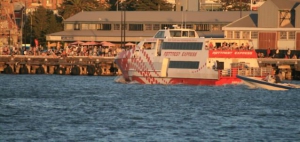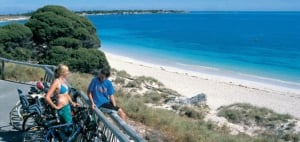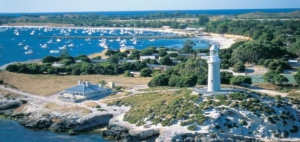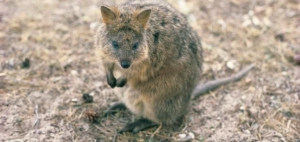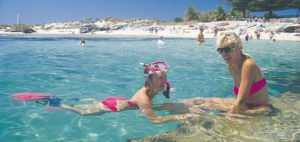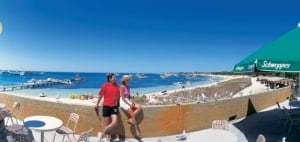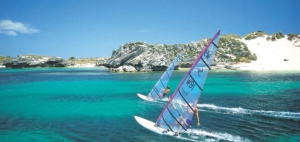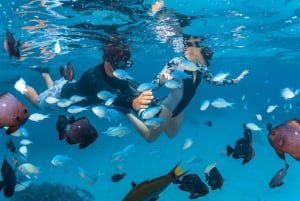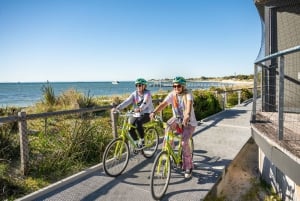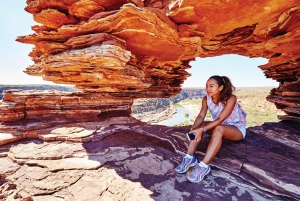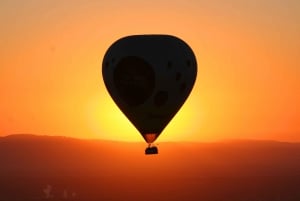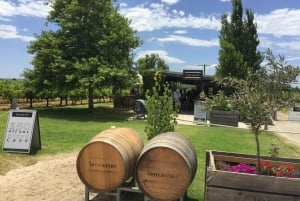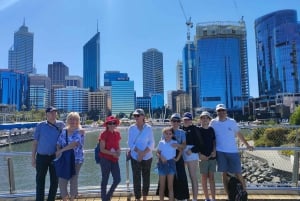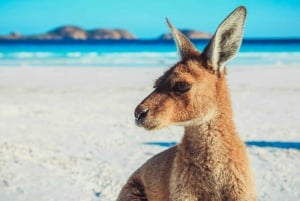Rottnest Island
Rottnest Island or "Rotto" as the locals call it, is a sun-kissed 19 sq km paradise isle located 19 km off the coast of Perth. This compact island retreat (it is only 11 km long and 4.5 km at its widest) has 63 picturesque beaches and 20 beautiful bays – no wonder Rotto is a favourite holiday retreat of many locals and tourists. Half a million people visit this little island every year and once the Rotto bug has bitten you, you’ll be back for repeat visits too.
(Photo of Fish Hook Bay, Rottnest Island courtesy of Tourism Western Australia)
Rottnest Island has many sheltered bays and picture perfect beaches that make it fun for the whole family. These include The Basin, Geordie Bay, Little Parakeet Bay, Long reach Bay, Little Salmon Bay, Salmon Bay and Nancy Cove. With 63 beaches to explore, you’ll be terribly spoilt for choice.
(Photo of Rottnest Express Ferry arriving at E Shed Markets, in Fremantle Harbour courtesy of Tourism Western Australia)
Rotto is just a ferry ride away. You can catch the ferry from Hillarys Boat Harbour, Fremantleand Barrack Street Jetty. Depending on the vessel and where you catch it from, ferry ride times can vary from 25 to 90 minutes. The following companies offer ferry services: Rottnest Express, Rottnest Fast Ferries and Oceanic Cruises. We recommend that you take the 7.30 am or 8 am ferry and make it a full day at Rottnest in order to get the best out of your day trip. If you prefer to fly to Rotto, you can also book the Rottnest Air-Taxi or the Rotorvation Helicopter Services that depart from Jandakot Airport. The flight will take about 15 minutes and you will get some pretty stunning aerial views of Perth, Fremantleand of course Rottnest itself. What a way to go!
(Photo of couple with bikes at Kingstown, on Rottnest Island courtesy of Tourism Western Australia)
In order to keep Rotto a paradise, private vehicles are not allowed on tiny Rotto and so the best thing to do is to rent a bicycle there or from the ferry companies and just explore the island at your own pace. You can also bring your own bike on the ferry for a small fee. Rottnest has bike trails ranging from easy ones that are suitable for families to challenging ones which demand a certain level of fitness and competence on the bike. More information can be obtained from the Rottnest Visitor Centre located at the end of the jetty. If you prefer to explore Rottnest on foot, do stop at the Visitor Centre to get information on the walking trails that will take you to various historic sites, scenic coastal highlights and lookout points. You can also buy an all-day hop-on-hop-off bus ticket from the Centre. This bus will take you from beach to beach and the bus timetables are posted at the bus stops. In addition, a free bus service that traverses Thomson Bay, Geordie Bay, the airport and Kingstown Barracks is available. Alternatively guided coach tours can be booked at the Centre too.
(Photo of Bathurst Lighthouse and Thomson Bay, Rottnest Island courtesy of Tourism Western Australia)
Rottnest earned its unusual name in 1696 when a Dutch explorer, Willem de Vlamingh, mistook the island’s quokkas for rats. He called the island ‘Rott Enest’ (which means ‘rats nest’) and thus the name ‘Rottnest’ came about. 1696. The quokka is a marsupial (it has a pouch like the kangaroo) that is only found on Rottnest and certain parts of WA’s South Westregion. Rottnest has a fascinating indigenous, colonial, maritime, military, environmental and recreational history. One unique thing that is relatively unknown is that Australia’s oldest continuously inhabited streetscape can be found on Rottnest’s Vincent Way. Take a stroll and visit some of the island’s historical buildings and sites such as the Salt Store, Lomas Cottage, the Boys’ Reformatory and the Hotel Rottnest. You can pick up a brochure from the Visitor Centre that provides more information on the island’s historical buildings. The Rottnest Island Museum is another good place where you can learn more about the island’s history. Rottnest played an important role in the both World Wars and military history buffs may enjoy exploring Oliver Hill Battery, the WWI Prisoner of War Internment Camp Site and the Signal Station and Battery Observation Post. If you go on the Oliver Hill Train Tour, you will also get to ride the 'Captain Hussey’ train, tour the tunnel system and see the islands’ 9.2 inch diameter guns. Maritime and indigenous history enthusiasts should not miss out on visiting the Wadjemup Lighthouse which offers guided tours, the Pilot Boathouse, the Aboriginal Burial Ground and the Lodge which used to be the Aboriginal Prison. In addition, there are several other guided tours that take you to different points of interest. Some of these tours are free and conducted by volunteers. Visit the Salt Store for more information on these tours.
(Photo of a quokka (Setonix brachyurus), on Rottnest Island courtesy of Tourism Western Australia)
Rottnest’s biodiversity and stunning natural beauty has earned it an ‘A’ class reserve status. This reserve and its flora and fauna are highly protected. It has more than 20 types of coral, 95 species of tropical fish, 260 types of native fish and 140 native plants. There is also an amazing variety of birds found here – a birdwatcher’s delight indeed. It is interesting to note that Rottnest was originally connected to the Australian mainland but became an island about 7000 years ago when sea levels rose and submerged parts of the land. This separation allowed some of its plant and animal life to evolve differently from that on the mainland. The most famous of Rottnest’s fauna is the cute quokka. It is not harmful to humans and is usually very friendly. However people are not allowed to touch or handle them in any way and risk getting a hefty fine if they do. Please don’t feed them because the herbivorous quokkas will get sick if they eat our food. There are about 8,000 – 12,000 quokkas on Rottnest. From March to August, young baby quokkas called joeys will often try to keep warm in their mothers’ pouches. Take a stroll at Garden Lake to see these adorable nocturnal creatures. You can also go on the popular quokka tours that depart from the Salt Store. The marine life around Rottnest is very diverse too. Dolphins can often be spotted in its waters. There is a colony of New Zealand fur seals at Cathedral Rocks and during September to early December, Humpback Whales can often be spotted from the West End of Rottnest as they proceed on their migratory routes. And when you snorkel, you may see sea slugs and brittle slugs, especially in the waters of The Basin. There are several different tour operators that offer various tours (depending on the season) such as whale watching, snorkelling, diving, catamaran sailing and fishing.
(Photo of the Basin at Rottnest Island courtesy of Tourism Western Australia)
Rottnest is just wonderful for all kinds of water based activities. You can go swimming at one of the sheltered bays or windsurf on the turquoise blue water. Popular swimming spots include The Basin, Thompson Bay, Army Jetty, Little Salmon and Pinky Beach. Snorkelling is a favourite activity of many visitors and don’t worry if you don’t have your equipment - just rent what you need from the ferry companies and the island’s bike hire company then explore the snorkel trails at Little Salmon Bay and Parker Point. Kingstown Reef is another favourite snorkelling spot. Diving is yet another option but you will have to make advance bookings and arrangements with diving operators that are based in Perth. Rottnest’s reefs and 13 shipwreck diving sites are some of the best in WA. Other activities that are popular include surfing, kayaking, bodyboarding and fishing. Surfers will love riding the break at Strickland Bay which has been voted as one of the world’s top 50 breaks. You can hire your gear from the bike hire company.
(Photo of Thomson Bay, Rottnest Island courtesy of Tourism Western Australia)
There are several Food and Beverage outlets on the island. These eateries range from restaurantsand cafesthat serve seafood to fast-food outlets. There are various accommodation options for visitors who want to spend more time on the island. These include a hotel, self-catering units, serviced apartments, campsite and backpacker hostel accommodation. If you plan to stay at Rottnest for an extended period of time and have access to cooking facilities, we suggest that you bring some additional drinking water and food (for example dried/canned food, bread, fruits and snacks). Being isolated from the mainland, Rottnest Island is not self-sufficient in its water supply and everything, included water and food, is brought in by boat from Fremantle daily. Therefore things can cost a little more on Rottnest. Alternatively, you also can buy what you need from the island’s General Store if you prefer to travel light.
(Photo of windsurfing off Rottnest Island courtesy of Tourism Western Australia)
Several important eventstake place on Rottnest every year. This includes the famous Rottnest Channel Swim that sees thousands of swimmers attempt the 19.7km swim from Cottesloe Beach to Rotto’s Thomson Bay. This February event is the world’s longest open water swim. Another major event is the solemn ANZAC Day Service that is held at dawn every April.
And finally, here’s a friendly reminder: remember to bring lots of sunscreen, a sun hat, comfortable shoes, light clothing, your sunglasses and a water bottle or two. Don’t forget your swim gear and a mat or towel to lie on too. Enjoy your trip to Perth’s favourite getaway retreat!




